Phra Kaew is a Royal temple and one of the oldest in Chiang Rai.
After visiting Wat Mung Mueang, we turned into Trairat road, our GPS started giving all wrong directions, I don't know why. We just started walking without realising where we were going, We walked and within few minutes saw the wat on our left side.
On entering, I was impressed by the sheer size of this wat.
History and journey of the Emerald Buddha or Phra Kaeo Morakot:
So important and sacred, the Emerald Buddha needs some introduction. Morakot is emerald in Thai. According to Ratna Phimwong chronicle, the Emerald Buddha was sculpted around 234 B.C. by gods as a gift to Nagasen Thera of Patliputra, now in Bihar, India.
The image was moved to Sri Lanka. King Aniruddha or Anawrahta of Pagan, Myanmar requested the tripitaka and the Emerald Buddha.
The boat carrying the image accidentally got swept ashore in Cambodia. The newly acquired treasure travelled a long journey moving from place to place, from Angkor in Cambodia, then to Ayudhya, Lopburi and Kampaeng Phet in Thailand.
In 1390 A.D., King Mahabhrom of Chiang Rai took the image from Kampaeng Phet and hid it behind a stucco inside the pagoda of Wat Pa Yier, (the present Wat Phra Kaew) Chiang Rai.
After 1434, the stupa being hit by lightening, revealed the emerald Buddha.
Journey of the Emerald Buddha:
- In Chiang Rai for 45 years from 1391 to 1436 in Wat Pa Yier (Wat Phra Kaew by King Mahabhrom)
- After this, King Sam Fang Kaen of the Lanna Kingdom wanted the image in Chiang Mai which was the capital at that time. The image was placed on the back of an elephant and asked to take it to Chiang Mai, but the elephant turned towards Lampang repeatedly three times. So, the Emerald Buddha graced Lampang.
- Lampang (South Thailand) for 32 years, from 1436 to 1468 in Wat Phra Kaew Don Tao
- In Chaing Mai for 85 years from 1468 to 1553 (shifted by King Tilokraj and kept in Chedi Luang) Wat Chedi Luang
- Laos for 225 years from 1553 to 1778 (shifted first to Luang Prabang and then to Vientiane by Chiang Mai's King's grandson, King Setththirath)Prince Chaiyachetta. In 1778, Thailand captured Vientiane and brought the Emerald Buddha back to Thailand.
- Wat Arun was home to the Emerald Buddha for five years (1779-1784) which was brought by King Rama I from Laos and later shifted to Wat Phra Kaew in 1784.
- In Wat Phra Sri Ratana Sasdaram in Grand Palace, Bangkok from 1784, after it became the capital to present.
It is now located in grand palace and enshrined in the royal chapel of Wat Phra Kaew, the emerald watches over the Thai nation.
The Department of Fine Arts registered the site as a historical monument in 1935. In 1978, Wat Phra Kaew was designated as Royal temple, the first in Chiang Rai.
History of wat:
Phra Kaew was named as Wat Pa Yier or temple of the Bamboo Grove after the species of bamboo native to Chaing Rai, Cephaiostrachyum virgatum (family: Graminea)
In 1434 A.D., a lightening struck the temple pagoda (Phra Chedi), broke open revealing a Buddha image, where it was hidden inside the chedi by King Mahabhrom. The image was kept in the abbot's residence. A part of the plaster came out after some time and revealed a green color, no one at that time knew that the image was of jade.
This event made the people of Chaing Rai to rename the temple as Wat Phra Keo, meaning "Wat of the Holy Glass Buddha" and the image came to be known as Phra Kaew Morakot meaning green color in Thai.
In B.E. 2521 or 1978, H.M. King Bhumiphol bestowed the wat to royal temple, the first one in Chiang Rai.
Things to see in this wat:
There is so much to see here.
- Emerald Buddha in ubosoth and panels surrounding the image
- chedi where the Emerald Buddha was found
- viharn and presiding deity, Buddha's two disciples
- museum

main entrance to wat
the gate we entered
what to see in this wat
more information on wat
King Mengrai, founder of Chiang Rai
Buddha Rattana Mengrai under a bodhi tree very close to chedi
klong puja or puja drum or worship drum
bells near the chedi
Phra Ubosot or the chamber of Jade Buddha:
The chamber is built in Chiang Saen style, where the inside is very small.
The small ubosot gives security and prosperity to those who visit it. The building was constructed in 1890 A.D., it was renovated in 1960 and latest renovation was completed in 2007 when the H.R.H. Princess Maha Chakri Sirindhorn raised the chofah.
entrance to wooden ubosothchofah on top
The image in the center here is a replica of the original Phra Kaew Morakot. It is very similar to the original but is 45 cms shorter as a sign of respect. It was made in China from Canadian jade and installed in ubosoth in 1991.
Phra Yok Chiang Rai or the Jade Buddha of Chiang Rai is the presiding deity.
The image was made in honor of the 90th birthday of Her Royal Highness, Princess Srinagarindra, the Princess Mother.
Phra Yok Chiang Rai sits on a movable throne made from golden carved wood. It has 7-tier umbrella of kingship on top.All around the room, are murals which show the emerald's journey. The above one shows everyday Lanna life.
the pond near the ubosoth is said to have giant turtles, but I could not see any
Praying to Buddha images outside the ubosoth. "Wishing and praying that business be successful. May I have a good fortune and be blessed." This is what it says on top.
klong puja kept by the side of ubosoth
Klong puja are drums of wood which have cow or deer skin attached on both ends which need to be stretched off and on with strips of skin.
This drum is used in religious ceremonies in temples.
Buddha images under a bodhi tree, straight in front is Phra Song Kad Jai or Katyana or Mahakaccana, who was a great disciple of Gautam Buddha.Phra Thammarachanuwat:
Phra Thammarachanuwat was the abbot here at Wat Phra Kaew.
Going from my left to right: first picture is Buddha in Chiang Saen Singh1, in which the face is rounded, the top knot is the shape of a bun, protruding chin, hair in curls.entrance guarded by moms
Phra Thammarachanuwat
Chedi or the Pagoda:
The pagoda dates from founding of temple and it was in 1434 A.D. that the lightening revealed the Emerald Budha here in this chedi where it was hidden for so many years covered in stucco.
The stupa was later renovated in 1952 and 1954 and again in 1990 and then in 2015.
The chedi is octagonal at its base
bells behind the viharn
In front of chedi are seated 3 Buddha images in three Chaing Saen1, 2 and 3 forms.the middle figure is in Chiang Saen Singh 2, which is very similar to the first one, top knot is different, face is little elongated, the robe above the navel.
On the extreme right is Singh 3, the top knot is more higher, robe touches just the navel.
gong in front of stupa
another gong beside stupa
On November 26, 1998, H.R.H. Princess Galayani Wattana presided over a ceremony to raise the "Chatr", tier.
Viharn:
The Lanna style viharn is guarded by two large naga on either side of stairs.
The viharn though not very big but is very intricately decorated.
sign outside viharn
viharn wih naga on roof
eyebrow pediment
main image
The bronze presiding deity, Phra Chao Lan Thong Buddha is in bhumisparsha mudra, position of calling the earth to witness.
The image is two meters wide and over three meters high and is the largest and most beautiful image in Thailand.
It was earlier in Wat Phra Chao Lan Thong in Chiang Saen, and then moved to Wat Ngam Muang. It was later on 9th November, 1961 brought to its present place.
Phra Chao Lan Thong Buddha image is said to be 700 years old.
Buddha is various postures on the side of viharnContemplating Buddha which signifies silent determination and tolerance for others
Phra Upakut or Upagupta
Upagupta was a Buddhist monk and spiritual teacher of Ashoka, the Great.
Phra Phutthiwong Wiwat:
Very close to the museum is a small shrine for Phra Phutthiwong Wiwat.
Phra Phutthiwong Wiwat was abbot of this wat and head monk of Chiang Rai province. Before 1957, when Wat Ngam Muang was in ruins, he got two images to this wat.Two of ten great disciples of Gautam Buddha are here in this wat. On the right side of main Buddha image is Moggalana and Sariputta on his left. (Mahamaudgalyayan and Shaliputra in Sanskrit)
Hong Luang Saeng Kaew Museum:
The two-storey museum is built of teak,
The Lanna style building with dark wood and gold looks very pretty. The bargeboards on the roof have golden naga serpents.
morm at entrance
The morm is a sacred deity and is usually depicted at the entrance. It is the manifestation of angel Patchunna, deities group that include tiger and lion. In times of drought, villages make an image of Morm and take out a procession around the village to bring rain.
Phra Buddha Sri Chiang Rai, the main Buddha and other articles on ground floor. A golden hansa or hintha can be seen on side.
some museum collections
on way to first floor
images on the first floor
The museum displays artifacts of Lanna era from 1296-1558
Dracontomelon dao
The fruit, stem, leaves are of medicinal value.
The seed has patterns which remind of primitive Buddha images. It is said to be sacred and is known as Phra Chao Ha Phra-ong or seeds with five Buddha.
Thai tradition says that they see the shape of five Buddha ( Aksobhya, Amitabha, Amoghasiddhi, Ratnasambhava and Vairocana) on these sacred seeds. They are kept as lucky charm.
Important trees here:
The temple has 2 trees which are important in Buddhism.
Bodhi tree under which Gautam Buddha attained Nirvana. In the other picture is Sala tree under which he practiced meditation in a Sala forest. Both these trees were brought from India.
We sometimes, mistake Sala tree to be cannon ball tree which is not a native of India and is native of South America. It was brought to this region in the 19th century.
To the back of ubosoth, are the living quarters (kuti)of monks. Wat Phra Kaew is an active wat, monks live and study here.Timings:
temple : 0700- 1800 hours
museum : 0900- 1700 hours
Entrance : free


























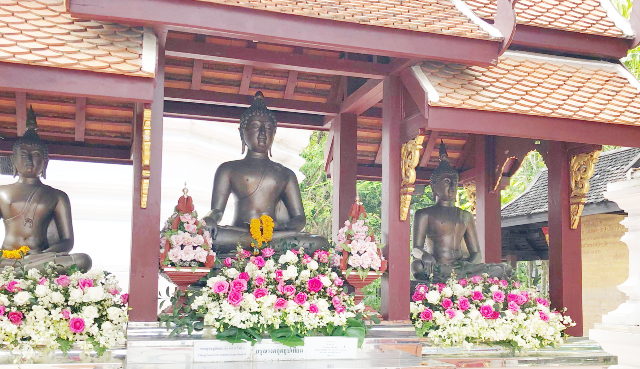



















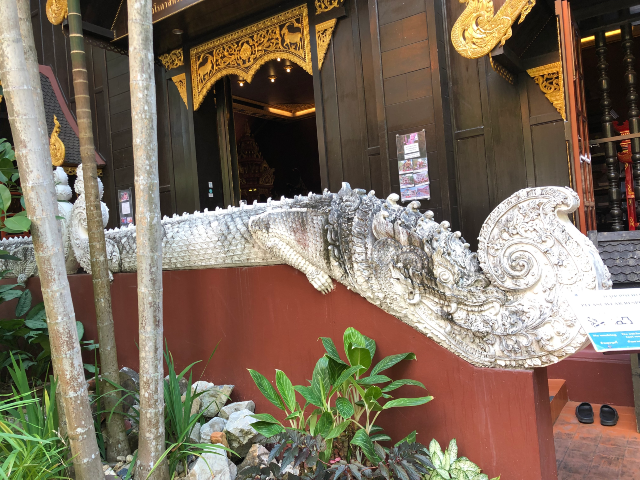







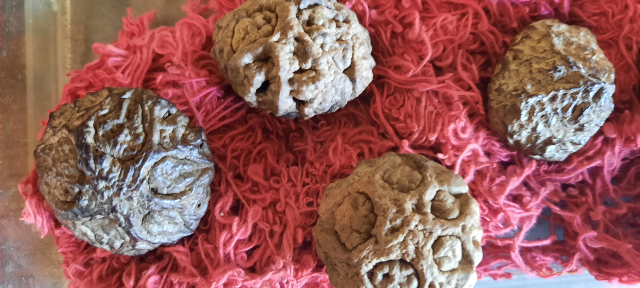
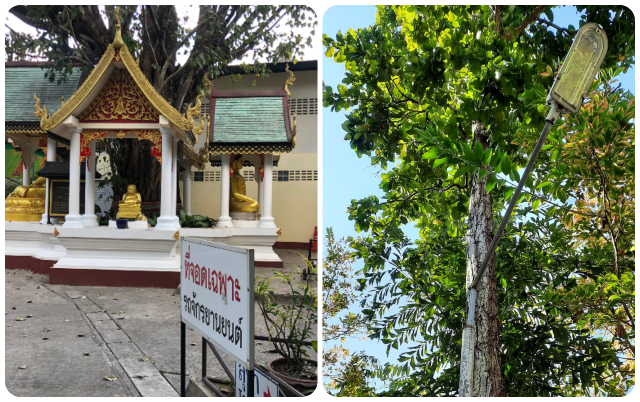
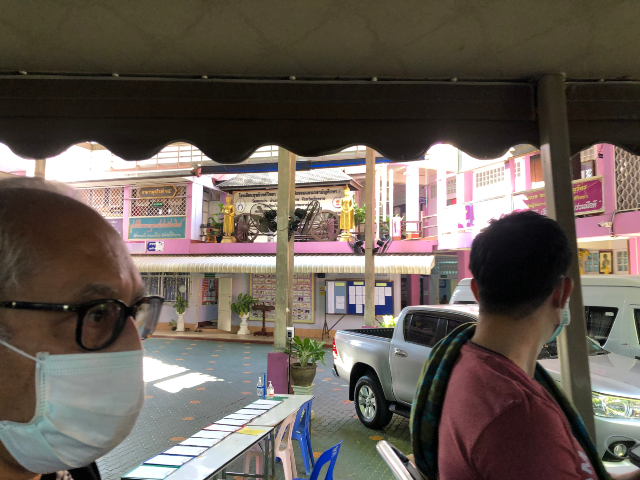
No comments:
Post a Comment
Thanks for visiting my blog. Your feedback is always appreciated.